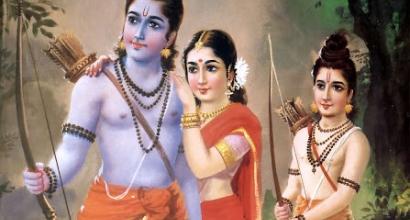Vastu
Vastu refers to the story or the plot of a play and is also referred to as itivṛtta. The vastu or itivṛtta is of two kinds – ādhikārika and prāsaṅgika.
The ādhikārika-itivṛtta refers to the main plot of the play – it is the primary story that runs through the play and is its most important thread.
For instance, in the Abhijñana-śākuntala of Kālidāsa, the story of Śakuntalā and Duṣyanta is the ādhikārika-itivṛtta (also referred to as ādhikārika-vṛttānta).
The prāsaṅgika-itivṛtta is a subsidiary limb of the main plot or a peripheral aspect of the main story. In the Abhijñana-śākuntala, Menakā rescuing Śakuntalā who was not recognised by the king, followed by the birth and growth of Bharat in the āśrama of Mārīca maharṣi constitute the prāsaṅgika-itivṛtta (also referred to as prāsaṅgika-vṛttānta).[1]
If the prāsaṅgika-vṛttānta is large it is called patākā and if small, it is called prakarī. Menakā rescuing Śakuntalā is an example of patākā; the episode in which forest deities offer ornaments and garments to Śakuntalā is an example of prakarī.
~
The vastu, i.e., the plot, is further classified as prakhyāta, utpādya, and miśra depending on the source of the story.
- If the main thread of the story borrowed from the epics, i.e., the Rāmāyaṇa and the Mahābhārata or the Bṛhatkathā (of Guṇāḍhya), it is said to be of the prakhyāta (literally ‘popular’) kind.
- The utpādya-vastu is a story which is a product of the poet’s imagination;
- The miśra kind of vastu is a blend of the first two, i.e., the poet could have made modifications to a well-known story to suit the needs of his plot.
Arthopakṣepa
The story of a play might contain segments which may bring boredom to the viewer if portrayed explicitly; there could be other segments which might cause aesthetic rupture or may be inappropriate to showcase on the stage. These can be suggestively brought about by the employment of arthopakṣepas. The kind of activities that are deemed inappropriate to be showcased on the stage, i.e., are anucita include a long journey, murder, war, loss of an empire, attacking a kingdom or a fortress, bathing, elaborate dining, putting on ointments and toilet activities, wearing clothes and sleeping. These should not be explicitly portrayed on the stage, i.e., they must not come as segments of direct enactment. The killing of the nāyaka (hero) should not be suggested or spoken about anywhere in the play. It is important to portray only such incidents which are gentle, profound, and elevate the minds of the connoisseurs. Every maker of the plot must keep in mind that every incident should be accountable to Rasa and must contribute towards enhancing the same.
The arthopakṣepas described by Bharata are:
- Viṣkambha/ viṣkambhaka – This constitutes the narration of events by the secondary characters of the play. Usually, an event which cannot be portrayed on the stage due to the need for propriety or because it can cause boredom to the audience when displayed in detail, is captured through the conversation between the secondary characters. Primary characters of the play do not occur in the viṣkambhaka, but the conversation may be concerning them. If the viṣkambhaka is enacted by the madhyama characters, it is named śuddha-viṣkambhaka and if it involves a mix of madhyama and adhama characters[2], it is termed as miśra-viṣkambhaka. The śuddha-viṣkambhaka is usually entirely in the Sanskrit language and the miśra-viṣkambhaka contains a mix of the Sanskrit and Prakrit languages.
- Praveśaka – This part of the play delineates the set of incidents which took place in the period between two consecutive acts. The narration is usually through nīca-pātras. Thus, it can be called an inter-act segment, a link between two acts. While the viṣkambhaka can occur at the beginning of the play as well, the praveśaka only comes between two acts.
- Cūlikā – This involves conversation between characters behind the screen. In this segment of the play, characters do not appear on the stage, but only their voice is heard, which usually indicates an event that has occurred or is currently going on.
- Aṅkāsya – As the characters exit from the stage at the end of an act, they may indicate the subject matter of the forthcoming act; this constitutes aṅkāsya.
- Aṅkāvatāra – The characters who suggest the content of the succeeding act may also take the stage at the beginning of the succeeding act; there is thus is a seamless transition between the two acts in such cases; this technique constitutes aṅkāvatāra.
Śrāvyāśrāvya
There are some segments of the play which fall under the category of śrāvya and a few others which are aśrāvya. They are
- Prakāśa – This constitutes speech and action which can be seen and heard by everyone, i.e., aspects which can be heard by all other characters on the stage as well as the audience. This falls under the category of śrāvya. In other words, the plot of the story allows for the particular utterance and action to be cognised by all characters on the stage.
- Svagata (soliloquy) – Svagata involves a character speaking its mind out loud; only the audience gets to hear the character’s thoughts; the other characters which may be present on the stage do not hear the soliloquy.[3]
- Janāntika – This involves a conversation between two characters on the stage; the audience gets to hear the conversation but the other characters on the stage ‘do not hear it.’ (as in, ‘speaking aside’).
- Apavārita – A character turns back and utters a confidential message to another seen (or unseen) character; the first character’s utterance cannot be heard by the audience as well.
- Ākāśabhāṣita – This stage technique involves a character that comes on to the stage and speaks to ‘the empty space’ as though in response to an unseen character. S/he may react by saying “What did you say? ….Ah! Is this so?” By doing so, the audience also gets to know the utterance of the unseen character and the response of the visible one. The visible character repeats the words it ‘hears’ of the unseen character and responds to them. This also helps the audience understand the incidents that have supposedly taken place.[4]
The current series of articles is an enlarged adaption of Prof. A. R. Krishnasastri's Kannada treatise Saṃskṛta-nāṭaka. They are presented along with additional information and footnotes by Arjun Bharadwaj.
[1] In fact, the episode of the death of a rich merchant and the king declaring that he would be the refuge to people in indeed in the sixth act of the play (around verse 23) is a good example for prāsaṅgika-itivṛtta; similarly, the finding of the fisherman who finds the ring in a fish’s body and is caught by the king’s men is another example for prāsaṅgika-itivṛtta.
[2] An uttama-pātra is a character which possesses noble traits and is said to be of the ‘superior’ kind; s/he plays the primary role in a play. The adhama- or the nīca-pātras in this context are characters of tertiary importance or least importance; (it does not necessarily mean that they possess baser traits as well). The madhyama-pātra constitute the average of the other two.
[3] This is indicated by an aspect of nāṭya-dharmī which involves the character who utters the soliloquy holding the tripatāka-hasta; these stage conventions can be classified as nāṭya-samaya.
[4] This technique is used in the praveśaka/viṣkambhaka segments of many popular plays.











































